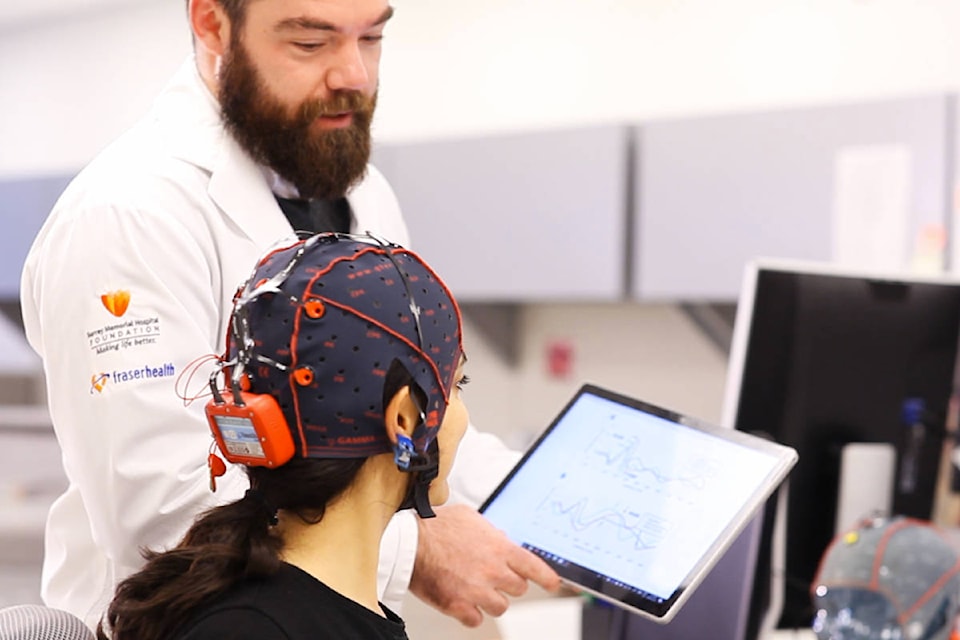“You can’t treat what you can’t measure.”
Just ask renowned Surrey-based neuroscientist Dr. Ryan D’Arcy, who, along with a research and development team, has created a new brainwave monitoring method called “Brain Vital Signs.”
Imagine a heart monitor, but for your brain. Or, as D’Arcy calls it “the first objective yardstick for brain function.”
The “disruptive” technology was put to the test in a multi-year Canadian-U.S. hockey concussion study in connection with the Mayo Clinic Sports Medicine Centre that tracked brain function in young Junior A male ice hockey players. It was done alongside the Health and Technology District and SFU.
The peer-reviewed study showed “existing concussion protocol tests may not be detecting brain function changes in young ice hockey players diagnosed with concussions.”
Meaning this new brain vital signs detection method has captured undetected physiological impairments diagnosed with concussions.
See also: ‘Game-changing’ Surrey-born technology tests brain vital signs
Dr. Ryan D’Arcy, above, has helped create a new brainwave monitoring method called “Brain Vital Signs.”
But it goes a lot further than that, D’Arcy explained.
“The results for this, they had three main things. First, when the players had concussions, the brain vital signs were very sensitive in detecting significant changes in brain function after concussions. Second, when players were cleared with existing clinical tests and returned to play, there were still found brain function deficits,” D’Arcy told the Now-Leader.
“Particularly in attention. Third, and of note, brain vital signs detected changes in cognitive processing speeds at the end of the season for players who did not receive any concussion diagnoses, implicating sub-concussive effects.”
D’Arcy said it’s hard to exactly what that means but that “we’re doing more research on it.
“There’s a lot of science coming out now, just the physical nature of the game is enough to cause sub-concussive changes in the brain. And Brain Vital Signs is sensitive enough to detect that.”
Shaun Fickling - the study’s lead author, and Ph.D. student at SFU - agreed.
“We also found that players who were not diagnosed with concussions showed decreased cognitive processing speed post season - thought to be the result of repetitive ‘sub-concussive impacts.’”
Brain Vital Signs Capture Undetected Physiological Impairments in Young Ice Hockey Players Diagnosed with Concussions from Health and Technology District on Vimeo.
He noted in the study, the brain vital signs method “went up against the best test” currently used in the medical field “and we were more sensitive.”
Head concussions in professional sports is a hot topic right now. Many athletes are retiring early because of concussions, such as 34-year-old NHL player Rick Nash, who announced his retirement in early January.
There are an estimated 1.6 million to 3.8 million sport-related concussions in the U.S. each year, according to the Mayo Clinic.
In Canada, there are about 210,000 reported concussions annually, reports the House of Commons Standing Committee on Health.
In an effort to tackle the issue, the Canadian government formed a health subcommittee on hockey concussions last year.
D’Arcy noted Brain Vital Signs software doesn’t just help diagnose concussions better than existing clinical methods, it has also allowed researchers to “provide a bit of a fingerprint” for concussions.
“It doesn’t require a baseline… we’ve found a unique pattern for a concussion.”
So, how does it work?
Simply put, the software behind the brain monitoring method outputs brain vital sign measurement units.
Scientifically speaking, BVS is a “neuroscience breakthrough for analyzing complex brainwave data that translates portable electroencephalography (EEG) data into a simple, practical and objective physiological evaluation of brain function or brain vital signs metrics.”
The breakthrough has the potential to make global change, said D’Arcy.
“It substantiates the public concern over concussions, with an objective physiological measurement of the brain,” he said. “That then will help across the globe to push for solutions.”
This study was “pivotal” in allowing the software to move forward, D’Arcy noted, adding that the team expects to submit its first Health Canada application in February.
“This is quickly going to be available to people on a wider scale,” he said. “Just like you can have a defibrillator right there, the goal is to have this technology where it needs to be.”
While the team chose to study the software’s impact on concussions first, D’Arcy said it can help with other brain conditions. Another study is underway that’s studying how it can help with dementia.
“It’s huge. It allows us to optimize our brain power. To live better and do amazing things in the world. Absolutely it’s a disruptive technology,” he added.
The research for Brain Vital Signs goes back two decades, but D’Arcy said it’s in the last five or six years that the team has been “really focused on” reverse engineering other vital sign detection methods, then applying it to the brain.
And, it’s truly a Surrey-born technology.
“It’s anchored to the Health and Technology District,” D’Arcy told the Now-Leader, of the research that’s gone into the software.
“It was an existing network but we’ve launched BrainNet and the work of brain researchers that come out of Surrey.”
The results of the study are out now, published in Brain: A Journal of Neurology, which D’Arcy called the “top journal in the field.”
amy.reid@surreynowleader.com
Like us on Facebook Follow us on Instagram and follow Amy on Twitter
